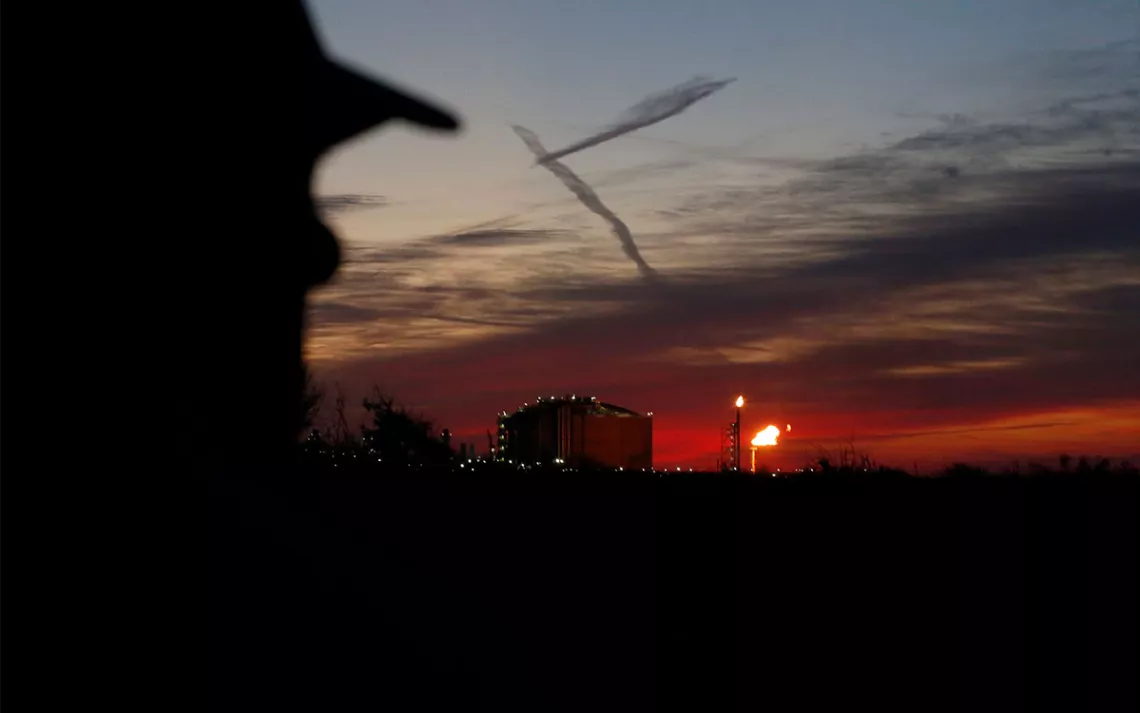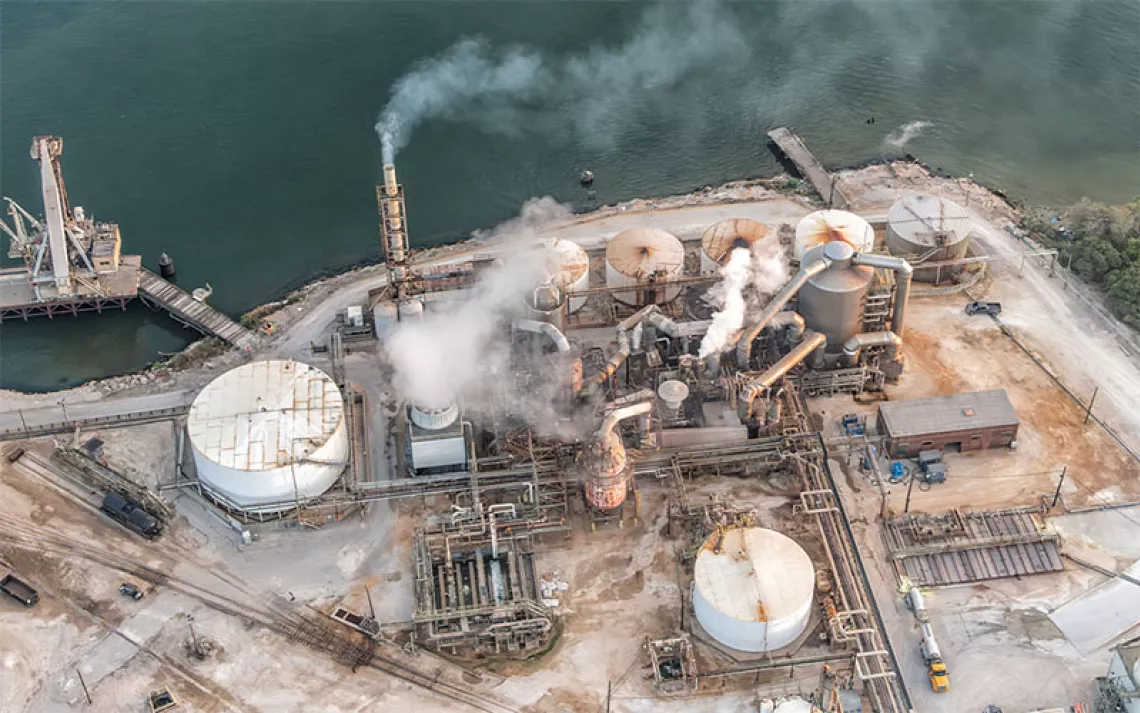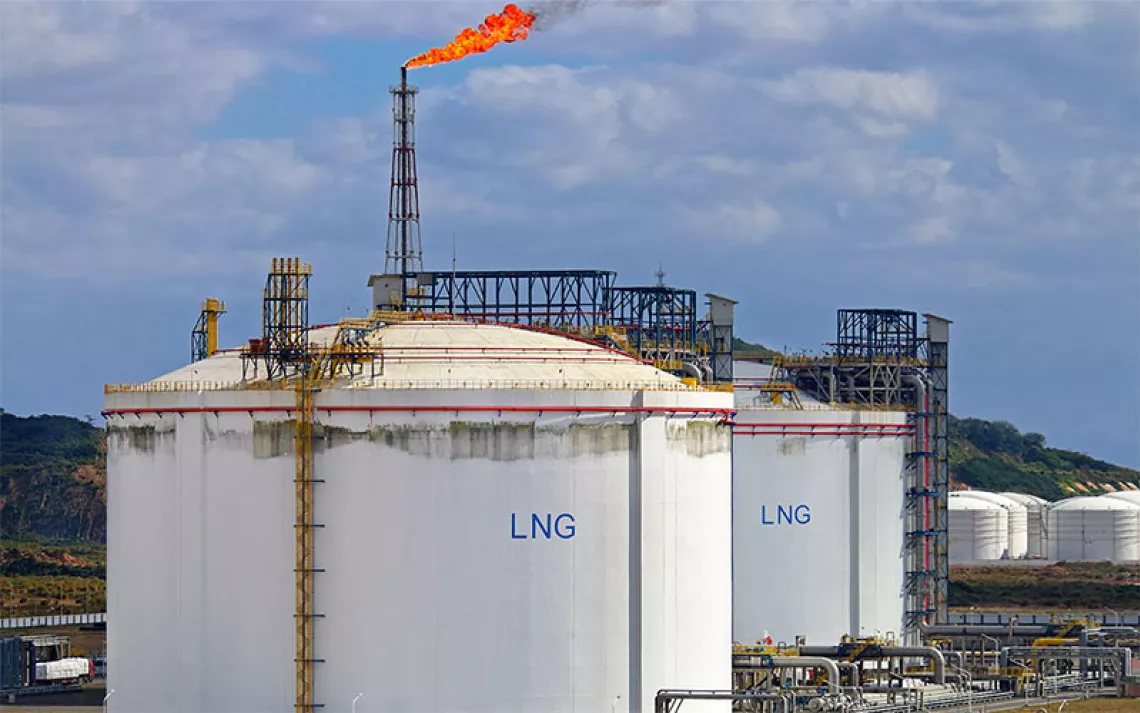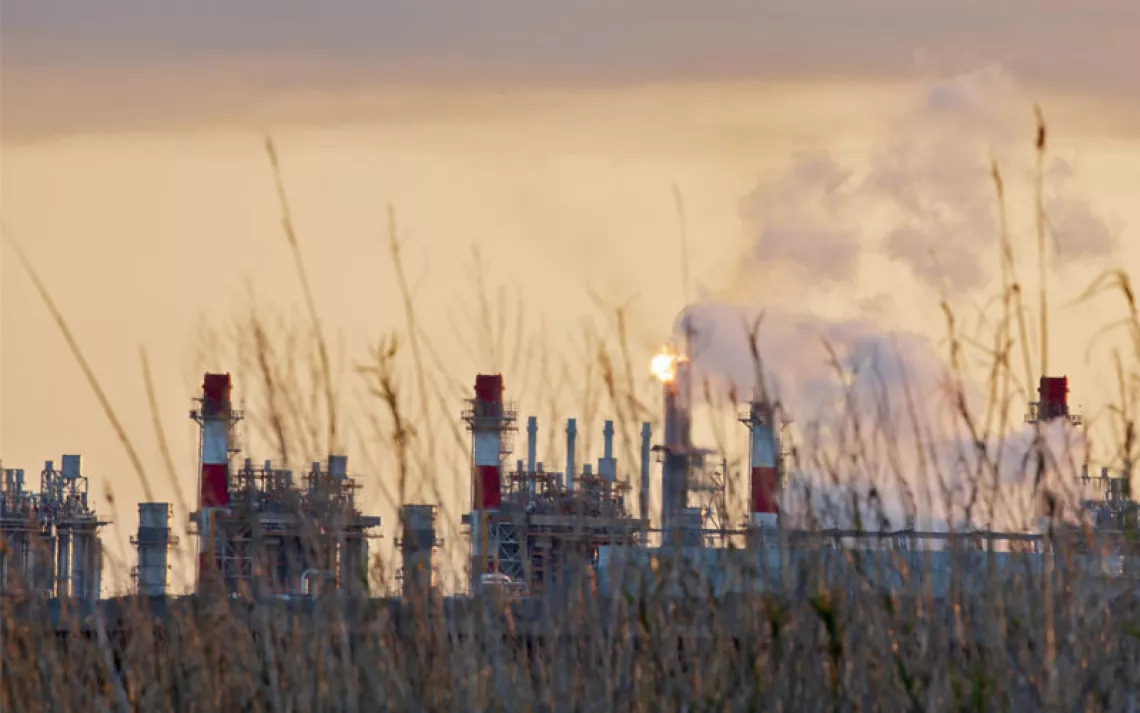This Liquefied Natural Gas Facility Is the Next Carbon Bomb
CP2 threatens local communities and global climate targets

John Allaire watches flames flare from a liquefied natural gas export facility next to his oceanside property in Cameron, Louisiana, in 2022. | Photo by Martha Irvine/AP
On the Louisiana coast, in Cameron Parish, plans are underway to build a massive, 550 acre, $10 billion liquefied natural gas (LNG) terminal called CP2 that would ship up to 24 million tons of gas each year, mostly to foreign markets. But CP2 is not just any other oil and gas project. It is the latest from Venture Global, a Virginia-based company that already has one other massive LNG terminal under construction in Louisiana. It is expected to be the next major greenhouse gas emission source approved by the Federal Energy Regulatory Commission (FERC) and has become a flashpoint for the massive buildout of LNG exports occurring across the Gulf Coast.
If the emissions of planned US fossil fuel exports like this were counted toward totals, US emissions in 2030 would be as high as they were in 2005. FERC will likely regard the LNG exports as “in the public interest,” especially as the war in Ukraine has reduced Russian gas exports.
This boon in LNG exports is very new: The US didn’t export LNG until 2016. Despite new fossil fuel projects being incompatible with a livable future, companies like Venture Global have helped the US rapidly become the largest exporter of LNG in the world, composing about 20 percent of the global market. Incredibly, the industry wants to double its LNG exports in the next three to four years, said Robert Howarth, a leading climate scientist at Cornell University.
As CP2 seeks final approval, Howarth’s latest research demonstrates that LNG exports create more emissions than coal does. And over the course of its lifetime, CP2 will create roughly 20 times more emissions than the Willow oil-drilling project in Alaska will.
“I’m amazed,” said Howarth, who noted that CP2 is being built even as the extent of climate warming is nearing “the possibility of dangerous tipping points." For the Biden administration to permit major emission sources like CP2—“I just find it mind-boggling,” he added.
A glimpse of the future
CP2 is striking both in its size—it is set to be the largest LNG export terminal in the Gulf—and also in that its future can be glimpsed by looking next door. There, on the same stretch of Louisiana coast, sits Calcasieu Pass, Venture Global’s identical but smaller LNG export terminal. And what does that future look like? Not good.
Over the past two years, Calcasieu Pass has been plagued by malfunctioning equipment, near-constant flaring, hundreds of emissions exceedances, and thousands of permit deviations, As a result, this year, it’s faced penalties from the state and legal action from its clients—all this and the terminal still isn’t fully operational yet.
“Whatever we know is happening at Calcasieu Pass, we can expect to be happening at CP2,” said Shreyas Vasudevan of the environmental group Louisiana Bucket Brigade. “Except that the volume of the exceedances in emissions will be way higher, so the potential of destruction for any sort of malfunction at the plant, any sort of accident, is so much higher than for other facilities.”
This is worrying because Calcasieu Pass has been plagued by technical failures and accidents.
In July, in the face of repeated violations, the Louisiana Department of Environmental Quality served Venture Global with a compliance order due to its failure to disclose incidents in a timely manner. Venture Global representatives said that all the issues have now been addressed and has also asked the agency to significantly increase its allowed emissions.
But Vasudevan, environmental advocates, and nearby residents are skeptical that the technical problems are resolved. Calcasieu Pass has continued to have issues with turbines tripping, which in turn means the terminal loses power and vents gases directly into the atmosphere. “It’s clear that they’re bad faith actors,” said Vasudevan, who also said that Venture Global appears to be cutting corners in order to construct the terminals as quickly as possible.
John Allaire, a Cameron resident whose property is adjacent to Calcasieu Pass, has documented flaring almost daily—84 of its first 90 days in operation. This is a gross violation of the project’s environmental impact statement, which predicted flaring would be a rare occurrence. Earlier this year, Allaire, through the Sierra Club, was involved in a lawsuit against FERC due to similar EIS violations when the agency approved a methane gas export facility.
Bucket Brigade calculated that Calcasieu Pass was out of compliance 83 percent of its first year. When compared to similar companies, this is a startling rate of failure. Monitoring reports from other, nearby terminals “look nothing like Venture Global’s,” and “it seems to be completely a Venture Global problem,” Vasudevan said. Calcasieu Pass was the fastest greenfield LNG facility ever built. The speed of construction, and its many technical failures, suggest that Venture Global is cutting corners as it builds terminals, Vasudevan said. “Venture Global really stands out as inexperienced … and very incapable,” even compared to its competitors, he added.
Venture Global is also facing contract arbitration from multiple clients, like BP and Shell, who accuse the company of failing to fulfill its contract due to malfunctioning equipment, and using money for repairs to build CP2 instead. And whatever Calcasieu Pass has done, CP2 can be expected to do in spades. The new facility, whose construction is expected to take three years to complete, will produce roughly twice as much LNG as Calcasieu Pass does.
As the technical problems at the Calcasieu Pass terminal have continued for over a year without resolution, the prolonged issue “suggests a systemic problem at the facility,” Michael McKenna, former deputy director of the White House Office of Legislative Affairs, wrote.
Construction already harming community
Currently, CP2’s existence hinges on final approval from FERC, expected any week now. FERC’s environmental impact statement is allowed to consider only the facility’s effects when it comes to exports—not the upstream or downstream ones—and said CP2’s impacts would be “less than significant.” But already, the project has driven long-time residents away from their homes.
Travis Dardar, a member of the United Houma Nation, moved to Cameron from Isle de Jean Charles about eight years ago, after he was displaced from his ancestral home by rapid land loss in the face of erosion and warming, rising seas. For years, he fished off the Cameron coast, where the shrimp was plentiful and the air clear. His home was surrounded by undeveloped cow pasture. At night, he could hear the waves hitting the beach.
Then everything changed. “At first, it was just a rumor: LNG is coming, LNG is coming,” Dardar recalled. “Then all of a sudden, hundreds of yellow trucks were everywhere, like something right out of a movie, like an invasion.”
Dardar’s land was less than a mile from Calcasieu Pass. And CP2’s property line would be about 300 feet from his front door. Every day, noise and vibrations from the construction rattled his home, and the constant flaring alarmed him. Construction of the terminals, on acres of destroyed marsh, has also driven animals from their habitats.
“When they built this plant, we started having wild dogs in the neighborhood,” Dardar said. The wild dogs killed his neighbor’s dog and nearly killed his own. “And more than once, I woke up and had an alligator by my mailbox. It was pushing the wildlife [out]—so what do you think is going to happen when CP2 is built? It’s going to push them even farther.”
After months worrying that his family was being poisoned by emissions, and at risk from an explosion from malfunctioning equipment, Dardar—like every other family on his block—accepted a buyout earlier this year and moved inland.
Now, black gunk from dredging covers the beach. The fishing catch has collapsed: Dardar estimates he now catches less than half the shrimp and fish he used to bring home. Construction has also destroyed or blocked boat launches, and passing tankers threaten to swamp his small fishing boat.
Construction is moving ahead despite grassroots opposition, with the support of industry-friendly parish officials. Venture Global, which net over $10 billion in profits last year, received $184 million in tax breaks from Cameron Parish this year. James Hiatt, himself a former oil and gas worker from nearby Lake Charles, describes Venture Global as "an existential threat” in a region already wrecked by fossil fuel’s consequences, namely powerful hurricanes and rapid land loss. He wishes the Department of Energy would step in to stop the LNG buildout, but “nobody’s keeping them in check. Nobody.” Hiatt was at an October hearing hosted by the Louisiana Department of Natural Resources regarding Venture Global’s application for coastal use permits. He suggested that previous reporting, which framed Cameron residents as supportive of CP2, is misleading.
No one who spoke at the hearing was an actual fisher in Cameron, he recalled, and many who spoke in favor were themselves Venture Global employees who appeared to be reading from a script. Hiatt expressed frustration that Venture Global has received millions in tax breaks, even as it destroys the fishing industry and drives residents from their homes. “This company is god-awful,” he said.
This article has been updated since publication.
 The Magazine of The Sierra Club
The Magazine of The Sierra Club



